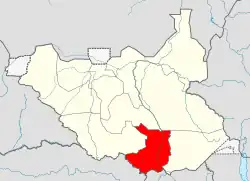Juba
Juba (/ˈdʒuːbə/)[1] is the capital and largest city of South Sudan. The city is situated on the White Nile and also serves as the capital of the Central Equatoria State. It is the most recently declared national capital and had a population of 525,953 in 2017. It has an area of 52 km2 (20 sq mi), with the metropolitan area covering 336 km2 (130 sq mi).
Juba | |
|---|---|
From top, left to right: View of Juba, John Garang Mausoleum Square, aerial view, United Nations (UTair) Boeing 737, White Nile river in Juba | |
 Flag 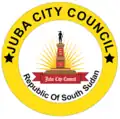 Seal | |
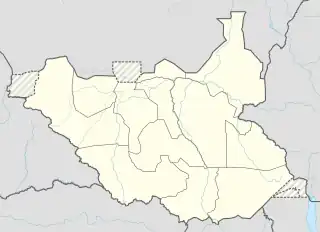 Juba Location of Juba in South Sudan | |
| Coordinates: 4°51′N 31°36′E | |
| Country | |
| State | Central Equatoria |
| County | Juba |
| Payam | Juba |
| Founded | 1922 |
| Government | |
| • Type | Mayor-council government |
| • Mayor | Stephen Wani Michael |
| Area | |
| • Capital city | 52 km2 (20 sq mi) |
| • Metro | 336 km2 (130 sq mi) |
| Elevation | 550 m (1,800 ft) |
| Population (2017 estimate) | |
| • Capital city | 525,953 |
| • Density | 10,000/km2 (26,000/sq mi) |
| Time zone | UTC+2 (CAT) |
| Climate | Aw |
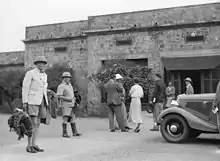
Juba was established in 1920–21 by the Church Missionary Society (CMS) in a small Bari village, also called Juba. The city was made as the capital of Mongalla Province in the late 1920s. The growth of the town accelerated following the signing of the Comprehensive Peace Agreement in 2005,[2] which made Juba the capital of the Autonomous Government of Southern Sudan. Juba became the capital of South Sudan in 2011 after its independence, but influential parties wanted Ramciel to be the capital. The government announced the move of the capital to Ramciel, but it is yet to occur.
History
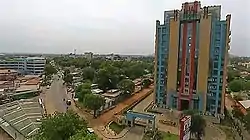
Under the Khedivate of Egypt, Juba served as the southernmost garrison of the Egyptian army, quartering only a handful of soldiers. Disease was common; soldiers often fell ill due to the malaria, meningitis and blackwater fever that was prevalent in the region. Explorers and campaigners Samuel Baker and Florence Baker used the nearby island of Gondokoro as a base during their expeditions to what is now South Sudan and northern Uganda from 1863 to 1865 and 1871 to 1873.[3]
The present city of Juba was established on the site of a small Bari village, also called Juba,[4] where the Church Missionary Society (CMS) had established a mission and the Nugent Memorial Intermediate School in 1920–21.[5][6][7] In the late 1920s, Anglo-Egyptian officials ordered Bari residents to relocate so that a new town could be constructed to serve as the capital of Mongalla Province.[8] The site was chosen by Anglo-Egyptian officials partly because of the presence of the CMS Nugent Memorial Intermediate School there, and partly because its proximity to river transportation on the Nile.[9][10] Major construction of the new city of Juba was underway by 1927.[8] Traders from Rejaf relocated to the new city in 1929, and the Governor's office of Mongalla was moved there in 1930.[11][12]
Greek merchants supplying the British Army played an early and central role in the establishment of Juba in the early 1920s.[13] Their number never exceeded 2,000, but because of their excellent relationship with the native Bari people and the large amount of resulting assistance they received, they built many structures in the downtown Juba Market area as well as in the area that the contemporary British soldiers called the Greek Quarter, which is today the small suburb of Hai Jalaba. Many of these structures are still standing today. Public buildings such as the Ivory Bank, Notos Lounge, the old Sudan Airways Building, Paradise Hotel, and the Nile Commercial Bank and Buffalo Commercial Bank were all built by Greeks. Greek merchants were responsible for the construction of the Central Bank building in the mid-1940s, as well as the Juba Hotel in the mid-1930s.[14]
From the establishment of Anglo-Egyptian Sudan in 1899 the British administerd southern Sudan seperatly from the north. In 1946, without consulting Southern opinion, the British administration began instead to implement a policy of uniting the north and the south. To facilitate the new policy, the Juba Conference was convened as a gesture to southerners,[15] the hidden aim being the appeasement of northern Sudanese nationalists and the Egyptian government.[16]
Until 1956, Juba was in Anglo-Egyptian Sudan, which was jointly administered by the United Kingdom and the Kingdom of Egypt. In 1955, a mutiny of southern soldiers in Torit sparked the First Sudanese Civil War, which did not end until 1972. During the Second Sudanese Civil War, Juba was a strategic location that was the focus of much fighting.
In 2005, Juba became the interim seat and the capital of the Autonomous Government of Southern Sudan after the signing of the Comprehensive Peace Agreement (before the agreement, Rumbek had been the proposed interim capital). With the advent of peace, the United Nations increased its presence in Juba, shifting its management of operations in Southern Sudan from its previous location in Kenya. Under the leadership of the United Nations Office for the Coordination of Humanitarian Affairs, the United Nations established a camp known as "OCHA Camp", which served as a base for many United Nations agencies and non-governmental organizations.
Juba became the world's newest national capital on 9 July 2011, when South Sudan formally declared its independence from the Republic of the Sudan. However, influential parties including the South Sudanese government expressed dissatisfaction with the city's suitability as a national capital, and the government proposed that a new planned city be built as a replacement capital elsewhere, most likely Ramciel in Lakes.[17]
On 5 September 2011, the government announced the capital of South Sudan would move some 250 km away from Juba to Ramciel, which is located in the middle of South Sudan, about 60 km East of Yirol West County, Lakes State. As of June 2020, the move has yet to occur.
In September 2015, nearly 200 people were killed in a tanker explosion in Juba.[18]
Since the beginning of the 2023 Sudan Conflict, approximately 6,000 refugees have arrived in the city.[19] Many settled in Gorom, an area near the city, and have struggled from lack of humanitarian aid.
Government
Juba is led by a city council, formed in March 2011. The council was established by Governor Clement Wani Konga who appointed Mohammed El Haj Baballa mayor of the council and former Yei County Commissioner David Lokonga Moses was appointed as deputy mayor. A ministerial committee to keep Juba clean and sanitary was also created by gubernatorial decree at the same time.[20]
In Michael Lado Allah-Jabu was appointed mayor of the city council following the removal of Kalisto Lado by Governor of Central Equatoria Emmanuel Adil Anthony.[21] Allah-Jabu was himself removed by Adil Anthony on 27 June 2023. Following his removal, Emmanuel Khamis was appointed caretaker mayor.[22]
Prior to March 2011, the area now administered by Juba City Council was divided into Juba, Kator, and Muniki payams. It is now a standalone subdivision of Juba County,[20] of which it is the county seat.[23]
Transportation
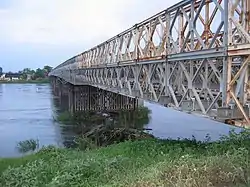
The city is a river port and the southern terminus of traffic along the Nile, properly called the Bahr al Jabal section of the White Nile. Before the civil war, Juba was also a transport hub, with highways connecting it to Kenya, Uganda and the Democratic Republic of the Congo.
After the war, Juba has no longer been a significant trade city. Roads and the river harbour are not in use due to disrepair. The United Nations and the South Sudanese government are repairing the roads, but full repair is expected to take many years. In 2003, the Swiss Foundation for Mine Action (FSD) started to clear the roads leading from Juba to Uganda and Kenya. It was expected that these roads would be completely de-mined and rebuilt in the course of 2006–2008. The rebuilding of the roads, which are mostly unpaved, takes a tremendous amount of effort and time because of the limited work season due to the lengthy rainy season, which lasts from March until October. The roads are important for the peace process in Sudan as people need them to return to their homes and to regain what they feel is a normal life. The first road that has started to be rebuilt is the road to Uganda. This road is particularly important, as many of the original inhabitants of Juba fled to Uganda during the war. As of 2009, there are three paved roads in Juba, one that was re-surfaced in July. The main one is a concrete road, built by the British in the 1950s.
Between 2008 and 2011, the Ugandan government and the South Sudanese government undertook joint efforts to develop a railway link between the Northern Ugandan city of Gulu and Juba, with an extension to Wau. A memorandum of understanding between the two governments was signed to that effect in August 2008.[24] The same memorandum outlined plans to develop the road network between the two countries. Recent media reports from the region suggest that the railway link from Juba may link directly with Kenya, bypassing Uganda.[25]
Juba International Airport (IATA: JUB, ICAO: HJJJ) is the site of large numbers of flights bringing UN and NGO (non-governmental organization) aid into Southern Sudan, as well as passengers and general air freight. The construction of a new terminal was begun in late 2007 when the oil prices were very high ($100+). Since then, with the oil prices going back down, the fate of the new terminal is uncertain. Building on the new terminal restarted in early 2014 As of February 2014, there are daily flights to Jomo Kenyatta International Airport in Nairobi, Kenya; Khartoum International Airport in Sudan; Entebbe International Airport in Entebbe, Uganda; and Bole International Airport in Addis Ababa, Ethiopia. The United Nations Mission in South Sudan (UNMISS) has a large compound near the Juba Airport.
Demography
In 2005, Juba's population was 163,442. Based on analysis of aerial photos, the best estimate of several donors working in Juba calculated the 2006 population at approximately 250,000. The 5th Sudan Population and Housing Census took place in April/May 2008, stating the population of Juba County to be 372,413 (the majority residing in Juba City, which dominates the county), but the results were rejected by the Autonomous Government of Southern Sudan.[26] Juba is developing very rapidly due to oil money and the Chinese coming for work and development. In 2011, the population of the city of Juba is estimated at 372,410, but may potentially be more.[27] As of 2013, the city's population was growing at a rate of 4.23%.[28] The city's CEO, Martin Simon Wani, has claimed the population exceeds one million with up to a million more living in surrounding suburbs.[29] Suburbs adjacent to Juba have become increasingly dense as people from the countryside move into the city for economic opportunities.[30]
| Year | Population | |
|---|---|---|
| 1973 (census) | 56,740 | |
| 1983 (census) | 83,790 | |
| 1993 (census) | 114,980 | |
| 2005 (estimate) | 163,440 | |
| 2006 (estimate) | 250,000 | [31] |
| 2008 (estimate) | 250,000 | [28] |
| 2011 (estimate) | 372,410 | |
| 2014 (estimate) | 492,970 |
Economy
Juba has been described as undergoing an economic boom, especially in the past five years and since independence. The prospect of an economic boom has brought thousands of merchants to Juba, mostly from northern Sudan and from East Africa. As of October 2010, several regional and international businesses have established a presence in Juba. The Commercial Bank of Ethiopia and the Kenyan banking conglomerate Kenya Commercial Bank has its South Sudanese headquarters in the city and a branch network of eleven (11) branches throughout South Sudan.[32] The three indigenous South Sudanese commercial banks namely; Buffalo Commercial Bank, Ivory Bank and Nile Commercial Bank, all maintain their headquarters in Juba. Equity Bank, another regional finance services provider also has a branch in Juba. National Insurance Corporation (NIC), the leading Ugandan insurance services provider, maintains an office in the city.[33] Despite recent economic difficulties brought about by the 15 December 2013 civil war, Juba has continued to grow and construction is still booming. This is probably due to the high demand for affordable housing and hotel accommodations. Research from the Overseas Development Institute found that markets in Juba are transient, as many traders only come to make a quick profit and so do not invest in storage facilities or shops.[34]
Juba is the fastest-growing capital city in Africa, with a population that has boomed from barely more than 100,000 people in 2005 to more than one million today. It has a frenetic boom-town feel, with businesses sprouting up everywhere – a brick-making factory that can't keep up with rising demand, new banks, a mobile phone company.
Education
- The University of Juba was founded in 1975.[35]
- Upper Nile University in Juba
- The Juba Public Peace Library was founded on 1 October 2019.[36][37] The library was donated by The South Sudan Library Foundation and contains over 13,000 books. It is the first public library of South Sudan. The South Sudan Library Foundation was co-founded by Yawusa Kintha and Kevin Lenahan.[37][38]
- Kampala International University[39]
- Catholic University of South Sudan
- Episcopal University of South Sudan
- Starford International University
- Ayii University
Health services
- Juba Teaching Hospital[40]
- Juba Military Referral Hospital
- Al Sabah Children's Hospital
- Nyakurun PHCC[41]
- Munuki PHCC
- Gurei PHCC
Places of worship
Among the places of worship, they are predominantly Christian churches and temples : Roman Catholic Archdiocese of Juba (Catholic Church), Province of the Episcopal Church of South Sudan (Anglican Communion), Baptist Convention of South Sudan (Baptist World Alliance), Presbyterian Church in Sudan (World Communion of Reformed Churches).[42]
Climate
Juba has a tropical wet and dry climate (Köppen: Aw),[43] and as it lies near the equator, temperatures are hot year-round. However, little rain falls from November to March, which is also the time of the year with the hottest maximum temperatures, reaching 38 °C (100 °F) in February. From April to October, more than 100 millimetres (3.9 in) of rain falls per month. The annual total precipitation is nearly 1,000 mm (39 in).
| Climate data for Juba (1971–2000, extremes 1931–1990) | |||||||||||||
|---|---|---|---|---|---|---|---|---|---|---|---|---|---|
| Month | Jan | Feb | Mar | Apr | May | Jun | Jul | Aug | Sep | Oct | Nov | Dec | Year |
| Record high °C (°F) | 42.2 (108.0) |
43.0 (109.4) |
43.6 (110.5) |
42.4 (108.3) |
43.7 (110.7) |
38.5 (101.3) |
37.0 (98.6) |
38.5 (101.3) |
39.0 (102.2) |
39.6 (103.3) |
40.4 (104.7) |
42.8 (109.0) |
43.7 (110.7) |
| Average high °C (°F) | 36.8 (98.2) |
37.9 (100.2) |
37.7 (99.9) |
35.4 (95.7) |
33.5 (92.3) |
32.4 (90.3) |
31.1 (88.0) |
31.6 (88.9) |
33.1 (91.6) |
34.0 (93.2) |
34.7 (94.5) |
35.9 (96.6) |
34.5 (94.1) |
| Daily mean °C (°F) | 28.2 (82.8) |
29.3 (84.7) |
29.9 (85.8) |
28.7 (83.7) |
27.6 (81.7) |
26.5 (79.7) |
25.6 (78.1) |
25.5 (77.9) |
26.4 (79.5) |
26.9 (80.4) |
27.4 (81.3) |
27.5 (81.5) |
27.5 (81.4) |
| Average low °C (°F) | 20.1 (68.2) |
21.7 (71.1) |
23.6 (74.5) |
23.4 (74.1) |
22.6 (72.7) |
21.9 (71.4) |
21.1 (70.0) |
21.0 (69.8) |
21.1 (70.0) |
21.3 (70.3) |
20.9 (69.6) |
20.0 (68.0) |
21.6 (70.9) |
| Record low °C (°F) | 11.4 (52.5) |
12.2 (54.0) |
16.3 (61.3) |
16.5 (61.7) |
16.8 (62.2) |
14.0 (57.2) |
13.3 (55.9) |
16.0 (60.8) |
15.5 (59.9) |
14.0 (57.2) |
13.2 (55.8) |
13.9 (57.0) |
11.4 (52.5) |
| Average rainfall mm (inches) | 5.1 (0.20) |
11.0 (0.43) |
36.7 (1.44) |
111.5 (4.39) |
129.9 (5.11) |
117.8 (4.64) |
144.7 (5.70) |
127.5 (5.02) |
103.7 (4.08) |
114.5 (4.51) |
43.1 (1.70) |
8.2 (0.32) |
953.7 (37.55) |
| Average rainy days (≥ 0.1 mm) | 1.4 | 2.0 | 6.6 | 11.6 | 12.4 | 10.3 | 13.0 | 11.5 | 8.6 | 10.4 | 6.5 | 1.9 | 96.2 |
| Average relative humidity (%) | 44 | 42 | 51 | 64 | 73 | 76 | 81 | 80 | 77 | 73 | 69 | 53 | 65 |
| Mean monthly sunshine hours | 279.0 | 235.2 | 210.8 | 198.0 | 207.7 | 207.0 | 182.9 | 204.6 | 228.0 | 241.8 | 237.0 | 260.4 | 2,692.4 |
| Percent possible sunshine | 76 | 67 | 57 | 54 | 62 | 58 | 50 | 57 | 63 | 64 | 68 | 68 | 62 |
| Source 1: World Meteorological Organization,[44] | |||||||||||||
| Source 2: NOAA (sun and humidity, 1961–1990),[45] Deutscher Wetterdienst (extremes, mean temperatures)[46] | |||||||||||||
Climate change
Juba, the capital city of South Sudan, has been severely impacted by climate change. The city, which is located on the White Nile River, is highly vulnerable to the impacts of climate change due to its low-lying elevation and proximity to the river. The impacts of climate change in Juba have affected the city's infrastructure, economy, and public health.[47]
One of the most significant impacts of climate change in Juba is flooding. The city experiences annual floods, which have become increasingly severe in recent years due to climate change. The floods have damaged infrastructure, including roads, bridges, and buildings, and have displaced thousands of people from their homes. The floods have also impacted the city's economy, with businesses and markets being disrupted by the floods.
In addition to flooding, Juba has also been impacted by droughts. The city, which relies on the White Nile River for its water supply, has experienced water shortages due to prolonged droughts. The droughts have impacted the city's agriculture, which is a significant source of income for many residents. The impacts of droughts on agriculture have led to food shortages and increased food prices, which have had a severe impact on the city's residents.
The impacts of climate change in Juba have also had significant public health consequences. The floods have led to the spread of waterborne diseases, such as cholera, which can be fatal. The droughts have also led to water shortages, which have increased the risk of waterborne diseases. The impacts of climate change on public health have been exacerbated by the city's limited healthcare infrastructure, which is already under strain due to ongoing conflicts and political instability.
The government of South Sudan, in partnership with international organizations, has taken steps to address the impacts of climate change in Juba. The government has developed a climate change policy and has established a climate change directorate to coordinate efforts to address the issue. The government has also worked with international organizations to implement adaptation measures, such as the construction of flood barriers and the development of drought-resistant crops.
In conclusion, climate change has had significant impacts on Juba, the capital city of South Sudan. The city has experienced severe flooding, droughts, and public health consequences due to climate change. Addressing the issue will require concerted efforts from the government, civil society, and the international community to build resilience and mitigate the impacts of climate change.
Notable people
- Aheu Deng, beauty queen and fashion model
- Bangs, rapper and YouTube personality
- Mangok Mathiang (born 1992), Australian-Sudanese basketball player for Hapoel Eilat of the Israeli Basketball Premier League
- Independent Moses Nunuh, first child born in South Sudan after its independence.[48] Like many other children in South Sudan, he died before his first birthday.[49]
Sports in Juba City
See also
References
- "Juba: is the capital of South Sudan, on the White Nile river. Pop: 250 000 (2006 est)". Dictionary.com. Retrieved 27 October 2013.
- Martin, Ellen; Mosel, Irina (January 2011). "City limits: urbanisation and vulnerability in Sudan" (PDF). Overseas Department Institute. Archived from the original (PDF) on 15 March 2017. Retrieved 22 October 2020.
- Shipman, Pat. To The Heart of the Nile: Lady Florence Baker and the Exploration of Central Africa
- Richardson, J.N. (1933). "Bari Notes". Sudan Notes & Records. 16 (2): 181–186.
- Keen, Rosemary (n.d.). "Church Missionary Society Archive, General Introduction and Guide to the Archive". ampltd.co.uk. Adam Matthew Publications, Pelham House. Retrieved 16 December 2016.
- Nalder, Leonard F. (1936). Equatorial province handbook. Anglo-Egyptian Sudan government memoranda. OCLC 3450641.
- Werner, Roland; et al. (2000). Day of devastation, day of contentment: the history of the Sudanese church across 2000 years Volume 10 of Faith in Sudan. Paulines Publications Africa. ISBN 9966215298.
- Badiey, Naseem (2014). The State of Post-conflict Reconstruction: Land, Urban Development and State Building in Juba, Southern Sudan. Boydell & Brewer Ltd. p. 38.
- Shuichiro, Nakao (2013). "A History from Below: Malakia in Juba, South Sudan, c. 1927-1954". The Journal of Sophia Asian Studies. 31: 139–160.
- Tuttle, Brendan (2021). "To the Juba Wharf". Juba in the Making. Juba in the Making. Retrieved 19 July 2021.
- Shuichiro, Nakao (2013). "A History from Below: Malakia in Juba, South Sudan, c. 1927-1954". The Journal of Sophia Asian Studies. 31: 139–160.
- "Juba in the Making". jubainthemaking.com. L'Humanité, Le Monde Afrique, & Internazionale.
- Shuichiro, Nakao (2013). "A History from Below: Malakia in Juba, South Sudan, c. 1927-1954". The Journal of Sophia Asian Studies. 31: 139–160.
- Greek Community of Juba Archives
- "Juba conf". madingaweil.com. Archived from the original on 11 March 2007. Retrieved 11 March 2007.
- Kenneth Okeny (1991). "The 1947 Juba Conference". Northeast African Studies. 13 (1): 39–58. JSTOR 43660336.
- "New capital city for South Sudan?". Radio Netherlands. 6 February 2011. Archived from the original on 29 June 2012. Retrieved 24 July 2011.
- Rubin, Jonathan M. (2006), "Liquefied Natural Gas Tanker Truck Explosion", Disaster Medicine, Elsevier, pp. 784–785, doi:10.1016/b978-0-323-03253-7.50160-6, ISBN 9780323032537, retrieved 9 November 2021
- Miettaux, Florence (8 September 2023). "From garrison town to goldrush city: life in Africa's youngest capital". The Guardian. ISSN 0261-3077. Retrieved 16 October 2023.
- Stephen, Juma John (3 April 2011). "CES Governor Appoints Mayor For Juba City Council". Gurtong. Archived from the original on 26 April 2014. Retrieved 28 July 2011.
- "Adil appoints new Juba mayor after Kalisto's dismissal". The City Review. 20 November 2021. Archived from the original on 10 January 2023. Retrieved 10 January 2023.
- Ninrew, Chany (27 June 2023). "Gov. Adil relieves Mayor Allah-Juba". Eye Radio. Archived from the original on 28 June 2023. Retrieved 28 June 2023.
- "Central Equatoria State". NileBuffalo Gazette. 2008. Archived from the original on 20 March 2011. Retrieved 28 July 2011.
- "Gulu – Juba Railway in the Offing". Pachodo.org. 20 September 2010. Archived from the original on 7 October 2011. Retrieved 20 June 2012.
- Thome, Wolfgang H. (14 September 2010). "Railway Link From Juba May Go Directly To Kenya". Eturbonews.com. Retrieved 20 June 2012.
- Isaac Vuni (8 July 2009). "South Sudan parliament throw outs census results". Sudan Tribune. Archived from the original on 12 July 2014. Retrieved 8 July 2009.
- "Estimated Population in 2011". Wolframalpha.com. Retrieved 20 June 2012.
- "The World Factbook: South Sudan". The World Factbook. Central Intelligence Agency. Retrieved 31 December 2013.
- Miettaux, Florence (8 September 2023). "From garrison town to goldrush city: life in Africa's youngest capital". The Guardian. ISSN 0261-3077. Retrieved 16 October 2023.
- Miettaux, Florence (8 September 2023). "From garrison town to goldrush city: life in Africa's youngest capital". The Guardian. ISSN 0261-3077. Retrieved 16 October 2023.
- "Estimated Population in 2006". Tripwiser.com. Retrieved 20 June 2012.
- "About KCB Southern Sudan". Kcbbankgroup.com. 4 March 2008. Archived from the original on 20 March 2012. Retrieved 20 June 2012.
- NIC Expands Into Sudan Archived 16 May 2009 at the Wayback Machine
- Irina Mosel and Emily Henderson (2015) Markets in crises: South Sudan case study London: Overseas Development Institute
- "Juba". Britannica Online. 20 July 1998. Retrieved 3 June 2023.
- "First public library opens in South Sudan, advocates for peace". The Christian Times. South Sudan. Retrieved 11 November 2019.
- "Instilling a culture of reading; South Sudan looks forward to new public library". Audioboom. 29 July 2019. Retrieved 11 November 2019.
- "MBA student establishes NGO to improve literacy in South Sudan". The University of Sydney. 7 February 2019. Archived from the original on 2 August 2020. Retrieved 11 November 2019.
- "S. Sudanese students lose court case against Kampala University". Eye Radio. 21 October 2022. Retrieved 10 December 2022.
- "Juba Teaching Hospital | EA Health". eahealth.org. Retrieved 10 December 2022.
- "NYAKURON PHCC – Juba County". southsudanpharma.org. Retrieved 10 December 2022.
- Britannica, South Sudan, britannica.com, USA, accessed on 8 September 2019
- "Climate: Juba – Climate graph, Temperature graph, Climate table". Climate-Data.org. Retrieved 27 October 2013.
- "World Weather Information Service – Juba". World Meteorological Organization (UN). Retrieved 21 March 2013.
- "Juba Climate Normals 1961–1990". National Oceanic and Atmospheric Administration. Retrieved 18 January 2016.
- "Klimatafel von Juba / Sudan" (PDF) (in German). Deutscher Wetterdienst. Retrieved 3 November 2016.
- "Young people responding to unprecedented flooding in South Sudan". Saferworld. Retrieved 30 April 2023.
- "The First South Sudanese baby named Independent". CBC News. 10 July 2011. Archived from the original on 17 September 2020. Retrieved 9 July 2012.
- Wynne-Jones, Ros (7 July 2012). "Happy Birthday South Sudan?". The Independent. Archived from the original on 11 November 2020. Retrieved 9 July 2012.
Independent Moses, like one in 10 babies in South Sudan, had not reached his first birthday, dying of Africa's biggest killer, diarrhoea.
External links
- Fisher, J. 2005, 'Southern Sudan's Front-line Town', BBC News, 20 April 2005.
- Holt, K. 2007, 'In pictures: Juba's Street Struggle', BBC News, 4 January 2007.
- Sudan And Uganda Sign MoU To Develop Infrastructure Archived 2 October 2011 at the Wayback Machine
- 'Gulu-Juba rail link underway'
- World's Newest Nation would Start Almost from Scratch – article & video by McClatchy
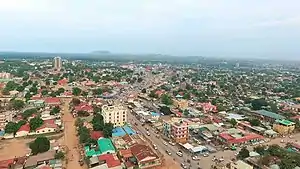

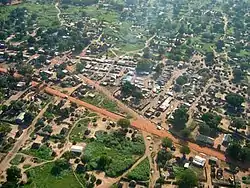
_Boeing_737-500-1.jpg.webp)

